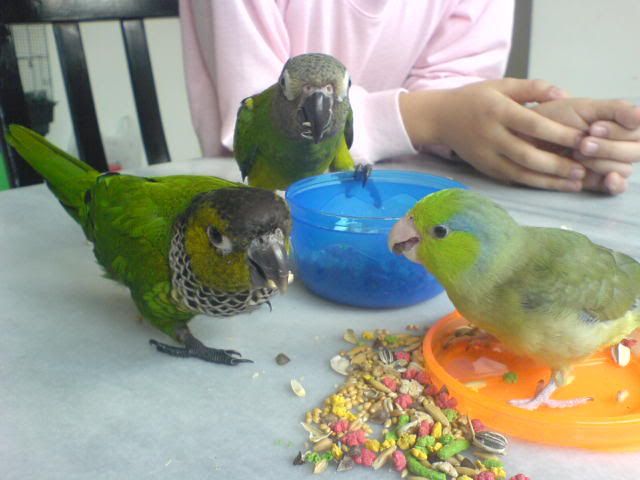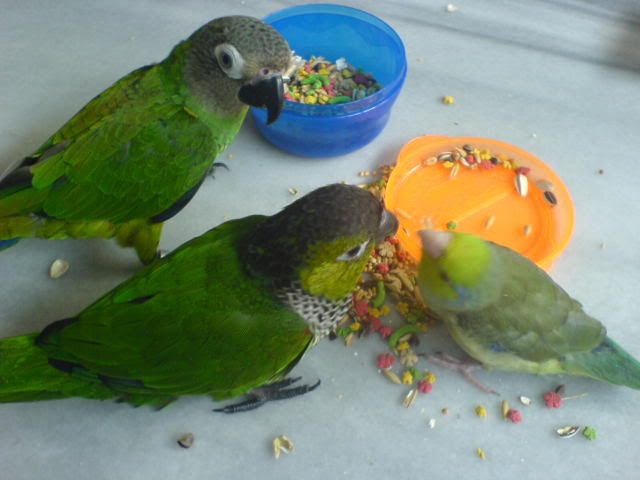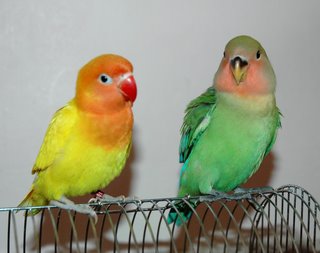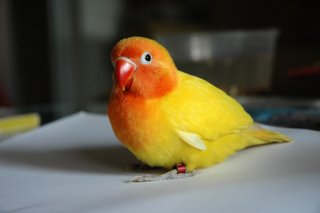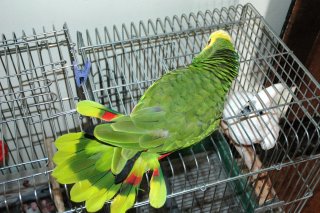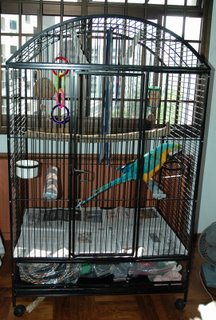A Guide to Parrots Caring
Acommodation Cage is often seen as a must for the birds, not as a place to imprison them but as a secure and comfortable night nesting ground wild equivalent . The principle to the sizes of the cage is as big as possible according to the respective sizes of the parrot species. Therefore the bigger the bird, the bigger the minimal cage size requirement. Care needs to be given to the cage bar spacing according to the size of the specie to reduce any possibilities accidents of.
A macaw’s jumbo cage
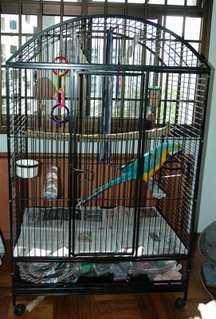
A jumbo cage made for a macaw. The bigger the cage the bigger, especially for these huge, hyperactive guys.

Bodhi's cage
 Play gym or stand are good places to allow the birds to be during their ouc time. There are specially designed, ready made ones commercially available or one can diy. A variety of different types of Toys are often added to the gyms so that the birds will not be bored and can enjoy themselves, being intellectually and physically engaged for hours on ends.
Play gym or stand are good places to allow the birds to be during their ouc time. There are specially designed, ready made ones commercially available or one can diy. A variety of different types of Toys are often added to the gyms so that the birds will not be bored and can enjoy themselves, being intellectually and physically engaged for hours on ends.
A diy tree gym made of natural acacia branches suitable for medium to large sized parrots.
Perches are an important component of parrots' accommodations as they spend almost their entire lives on their feet. It is thus prudent to be aware and consciously select quality perches for our birds.
Natural perches which come from non-toxic trees are the best as the bark serves as natural friction and traction for their feet and claws as well as provide something to chew, which is part of their natural behaviour.
Synthetic perches often take the forms of ropes, concrete, metal or plastic ones.
Concrete perches are good in offering some friction for the claws such that nail clippings need not be done as often. However, some poorly designed ones may affect the feet over prolonged usage by the bird.
Wooden dowels are the most readily available type of perches encountered commercially. They may serve adequately as a perch but can be a tad smooth for baby birds who are learning to perch. Generally speaking, variety is king in selecting perches for the parrots and therefore, it is good to have the various types of perches available for the parrots' standing pleasure be it in the cage or on the gyms or stands. Remember however, not to overcrowd with too many perches.
Food
Morning: Pellets with a scatter of seeds mix
Late Noon/Evening: Vegetables-fruits mix or sprouted grains/beans mix
Sunflower seeds are not given as a staple for Tara, Bodhi and Xiao Feng due to their high fat content.
Baby get 1 scoop each day though as he's a growing and hungry baby. Bodhi is especially susceptible to obesity as an Amazon and Tara because she is smaller in size and thus more vulnerable to a high fat diet.
To achieve a balanced diet for the parrots is an art in itself, where some species have unique requirements that need to be met. There are many articles and studies on it. So do check them out. Check out Article #3 if you are curious what a healthy parrot diet is like!
Bathing
Sometimes when I'm more free...Baby, Bodhi, Xiao Feng and Tara gets a bath....they usually gets it at least once a week...sometimes more, depending on the weather. Sunny weather usually means more bathing opportunities. They get to dry themselves on the play gyms. If it is sunny after their bath, their gyms are sometimes placed partialy exposed to the sun so they get some natural sunshine. Natural sunshine is a good source of vitamin D.
Hygiene
Baby's cages lining are changes daily due to the amount of waste she generate! Xiao Feng, Bodhi and Tara's cage linings are changed once in a few days.
The metal bars are swiped with clothes or towel papers to remove stains due to flinging of food, dropping stains, etc. The perches are scrubbed of any dropping or food debris, rinsed and sun-dried before putting back into the cage. These are done sporadically by my sis or me when necessary although some would prefer a weekly or monthly cleaning routine.
The rationale is to make their cages as clean as possible by changing the linings as frequently as possible. In the wild, they do not have problems in hygiene in the form of contact with their droppings because the forest is so huge!
Food bowls are washed daily and dried every time before refilling for the day.
Physical Maintenance
Wing clipping: This is done whenever they molt and their primary flight feathers grow out to ensure safety. Wing clipping is practiced to limit flight, i.e. inability to gain altitude when flying; NOT to eradicate flight altogether. They should be able to land safely on the ground in times when they decide they want to fly!
Nail Clipping: This is for both our safety and theirs. Claws are naturally polished in the wild due to activities that causes their claws to be in contact with frictional surfaces. Claws are clipped when that they do not injure themselves or ourselves.
OUC Time
OUC Time refers to Out-of-Cage Time. Parrots are not born to be imprisoned. In the wild, they would have ample space to fly, climb or walk! Given the sacfricies they made to be with us in domestic settings, ouc time will help increase the quality of their lives as our feathered friends.
Baby, Tara and Xiao Feng are let out everyday but the amount of time they are out are random. It can be long hours or lesser than half an hour; either on the play gym or cage top playing, depending on whether me, my sis or dad are around to supervise. Bodhi gets out of cage time daily, Bodhi usually just around his cage, or on the gym.
Especially for Baby, the macaw, she is let out as much as for the whole day. Having ample space to play, climb or just perch is very important to the well being of parrots as huge as these. They thrive on space and stimulations.
My flock are also often let out during feeding or cleaning times when we clean the cages or fill the food bowls.
Toys
Toys are an indispensable tool to keep our parrots occupied and exercising due to their captive situation where they no longer need to search for food, nesting sites or flee from predators. A collection of toys are reserved for all 4 birds. Basically toys can be grouped into 3.
Synthetic toys: Those made specially for parrots or for human babies.
Home Toys: Safe domestic materials that can be converted to toys for parrots to play, e.g. toilet rolls, newspapers, cleaned empty plastic bottles, etc.
Natural Toys: Natural non-toxic branches, leave and flowers. These are the "toys" parrots have in the wild! Once in a while, Baby, Bodhi, Xiao Feng and Tara get big fresh, non-toxic branches to play in and chew. They love the fresh branches a lot!! Its parrot paradise for them.
Foraging Toys: Working toys are toys that make the parrots "forage" to get treats, so as to simulate the natural setting of foraging and searching for food. Another way to simulate this natural foraging behaviour is to put clean pebbles in the food bowls or cover the food bowls with some safe chewable material so that the birds have to find their way to the seeds or pellets.
1-4 of these toys are placed in their cages at any single one time. They are cleaned and rotated. Natural and home toys are expendable, old ones being thrown away and replaced by fresh new ones.
Socializations
There is so much information for this topic that it can be written into a book all by itself!
Random one-to-one direct interactions.
Handling the bird in the form of Step Up Practice is an important direct interaction to be done with our birds on a regular basis. it is a form of direct interaction that allow both the bird and us to clear what cooperative and healthy relationship exist between both--us being the dominant member of the flock to eb trusted upon for safety, food and other material resource securities.
With Tara, it occasionally takes the form of trick learning. She currently knows 2 tricks and can perform one rather consistently.
Momentary direct interactions also occur spontaneously throughout the day to tell them we are still around. This is practiced in the form of spontaneous greetings, cuddles and dry kisses when we pass by our birds while doing our stuff.
Other forms of direct interactions includes talking to the bird, cuddling/scratching/preening, giving them treats etc.
It is also important that the birds are exposed to direct interactions with people other than the caregivers. So the birds occasionally gets to be exposed to different people and environment through mopa outings or when visitors to our home are interested enough to handle the birds.
For any bird excursion, safety is one of the highest concern. Ensure the bird is well clipped and do not have any behaviourial problems that make the bird dangerous to itself or the public, e.g. phobia.
Passive interactions throughout the day as my mum is often at home or when we are around and the birds' cages or stand are placed where they can observe going-ons.
Instructional interactions, teaching them how to play by themselves independently is very important. Wild birds spent most of their time searching for food, keeping a lookout for predators and breeding. A companion parrot who does not need to find food and worry about predators will thus have a lot of free time on its hands (or wings).
This is where playing and instructional interaction comes in. Some birds naturally learn by themselves the concept of playing and making themselves occupied. Others don't. Anyway, instructional interaction teaches the bird how to play and occupy themselves so that they are not over reliant on us or becomes bored. We play toys or shred paper/branches with them in a fun way while they are on their respective gyms. Another way would be the “picnic play”. A picnic cloth can be laid on the ground for hygiene and easy clean up. Toys are spread out on the floor and the birds and humans get to play together. Bodhi and Manju (a grey that used to be with us) enjoy this on the floor play time very much. They love the toys, each other’s company in playing and also us playing the toys together with them. It occasionally ends with some favourite treats of theirs—seeds! So you can get idea how the name “picnic playing” comes about! Also random.
Sleep
All 4 birds get their cages covered with clothes usually by 7 pm and uncovered around 7 am the next day. This is to reflect the natural amount of daylight and sleeping hours they get back in the wild...approx. 12-13 hours. Sometimes Bodhi and Xiao Feng will sleep much later due to disturbance from my night activities.
Cloth is used as cage cover so as to minimize disturbance that our night activities will have on their sleep. Be careful about the material. Those that can be chewed by the birds and sprayed have the potential of entangling them. There are birds that lost a toe or are strangled to death in this way.
Working Principles
There should be some underlying regularity to the care regime but there should also be some flexibility and randomness so that the parrots do not get fixated to certain rigid schedules, which is bad for their psyche and may result in behavioural problems.
Consistency is also important. Parrots have long lives and therefore there is a need to be consistent in the quality and quantity of care and love we offer them!! I know it may be hard at times...so the keyword is try to be consistent over the many years ahead!! This is where multiple care givers can make the difference. While one person's consistency in quality and quantity of care may fluctuate over time due to personal circumstances, other care givers can fill in for the lack in those times. Having several capable people as primary and secondary caregivers will reduce the chances of some behavioural problems such as one-person bird. It also helps in situations when we may not be around due to work or other leisure activities, e.g. overseas tour.
Vet Checkup
Routine checkups are good for the birds, especially if the bird is approaching middle age where some of the old age problems may start arising. Recommended routine checkup is once a year.
A purely physical examination cost around $20-40 dollars. A full health screening should include tests done on the blood and droppings which will of course, cost much more.
There are two views on checkups. One is that unnecessary checkups may expose the birds to infectious diseases at the clinic while another view is that routine checkup is a health guarantee so as to remedy any health problems before they escalate.
So far, Bodhi has been to the vet once for an irritated eye and Baby has been to the vet for an injured leg. I do not, however, bring them for annual checkup. This, however, will change once they get older when old age, long term diseases may set in and where health screening will be beneficial in detecting these problems early.
Conclusion
The above brief outline only covers the day to day care of parrots. They are however, sufficient to ensure you raise a healthy and happy parrot. However, it does excludes parrots that already carry with them behavioural or health problems.
If a parrot without any physical or behavioural problems baggage are cared for in the above manner, they are most likely to be happy, problem free and healthy parrots for life even though there might be periods (e.g. breeding, molting) that may test our consistency and patience. If the parrots are problems free, happy and healthy and we enjoy both their companionship and the care we give them, there are much fewer reasons or causes for selling or giving parrots away. This is one of the most important reasons the above was written in the first place.
For birds with behavioural or physical problems, additional care, socialization/training techniques, medical aids etc needs to be applied to remedy the situation.
Also, building up upon a healthy and happy parrot, we can enrich the relationship further by trick training or for certain species, speech learning.
Finally, breeding is not covered here.
For these topics, you can refer to many articles, books or experienced trainers, vets or breeders for answers!!!
 From left to right: Tweety's, Tara's, Casper's (of course a guest should have a present as well, isn't it?), Xiao Feng's, Bodhi's and Baby's.
From left to right: Tweety's, Tara's, Casper's (of course a guest should have a present as well, isn't it?), Xiao Feng's, Bodhi's and Baby's.














 The supplement powders have been pre-mixed before the photo is taken. Some supplements can be bought containing both kelp and alfalfa. I added pollen and I also recommend another possible addition in the form of wheat grass powder. Just be careful with the amount as these are supplements and not main components of their diet.
The supplement powders have been pre-mixed before the photo is taken. Some supplements can be bought containing both kelp and alfalfa. I added pollen and I also recommend another possible addition in the form of wheat grass powder. Just be careful with the amount as these are supplements and not main components of their diet.




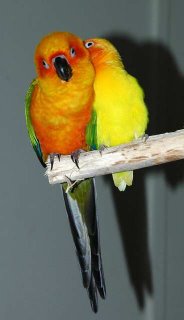

 Bodhi's cage
Bodhi's cage




